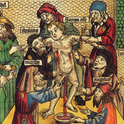In Hampstead on Thursday, Michael Palin and Terry Jones were among the celebrities attending a private view of photographs from the Western Sahara refugee camps. They were joined at the exhibition, which presents images of refugees from one of the world's longest and least-reported conflicts, by Western Saharan human rights activist Mohamed Fadel, 25, who fled to Britain last October having been tortured by Moroccan police.
The pair are no strangers to desert, having filmed the Life of Brian in Tunisia in 1978. Michael Palin also spent time in the Western Sahara in 2002. "I visited the camps on my Sahara series and was hugely impressed by the indomitable resilience of the Saharawi people,” he said. “These photos are a tribute to the spirit of hope over adversity."
Known as “Africa's last colony,” Western Sahara, was “given” to Morocco by the Spanish when they withdrew in 1975. A 16-year war ensued, followed by a ceasefire under whose terms the native Saharawi were promised a referendum on self-determination. Nineteen years later, they are still awaiting that referendum. Meanwhile, 165,000 Saharawis have lived in refugee camps in the desolate Sahara for over three decades. The exhibition, Thirst of the Dunes, is organised by the Free Western Sahara Network and showcases images from the camps by Robert Griffin.
About the size of Britain, Western Sahara lies along Africa's Atlantic coast. Descended from Bedouin Arabs who arrived in the 13th century and integrated with the Sanhaja population, the Saharawi have wandered the territory's deserts rearing sheep, goats and camels for centuries. They have a rich nomadic culture and traditions as well as their own distinct language, Hassaniya, a variety of Arabic.
In 1884, the Spanish colonised the territory but did not settle far inland, staying largely in port towns along the coast. However, the discovery in the 1960s of large phosphate deposits beneath the desert sands led to the setting up of a large Spanish mining infrastructure. It is these phosphates, essential for industrial agriculture, for which Morocco continues its unlawful occupation of the territory, together with other mineral resources, oil, gas and rich fishing waters. For over three decades, international law has been flouted whilst governments around the world are complacent or complicit in the occupation, and even profiting from it.
"Despite living in such harsh circumstances the Saharawi have not lost their sense of humanity, optimism, hope or humour,” said Griffin, the photographer. “It was truly a humbling privilege to meet them—and I hope that through my photos I've captured something of their spirit, generosity and quiet dignity.” Issa Brahim, one of the women featured in the exhibition, is a 33-year-old mother of four who was born and raised in the camps. She has no work, no water, no land for her goats to graze. But she is not without hope. The greatest of hopes is to set foot in her homeland for the first time.”
The exhibition, Thirst of the Dunes, runs until 25th August in the Rosslyn Arms, 48 Hampstead High Street, and also features work by photographer Dani Valera
"What have we done with the years, so distant and yet so close? Did they fall, squandered, between the oblivion of tradition and the thirst of the dunes?" —Saharawi poem
Two Pythons support the Sahara's refugees
July 30, 2010

The author with Terry Jones and Michael Palin











